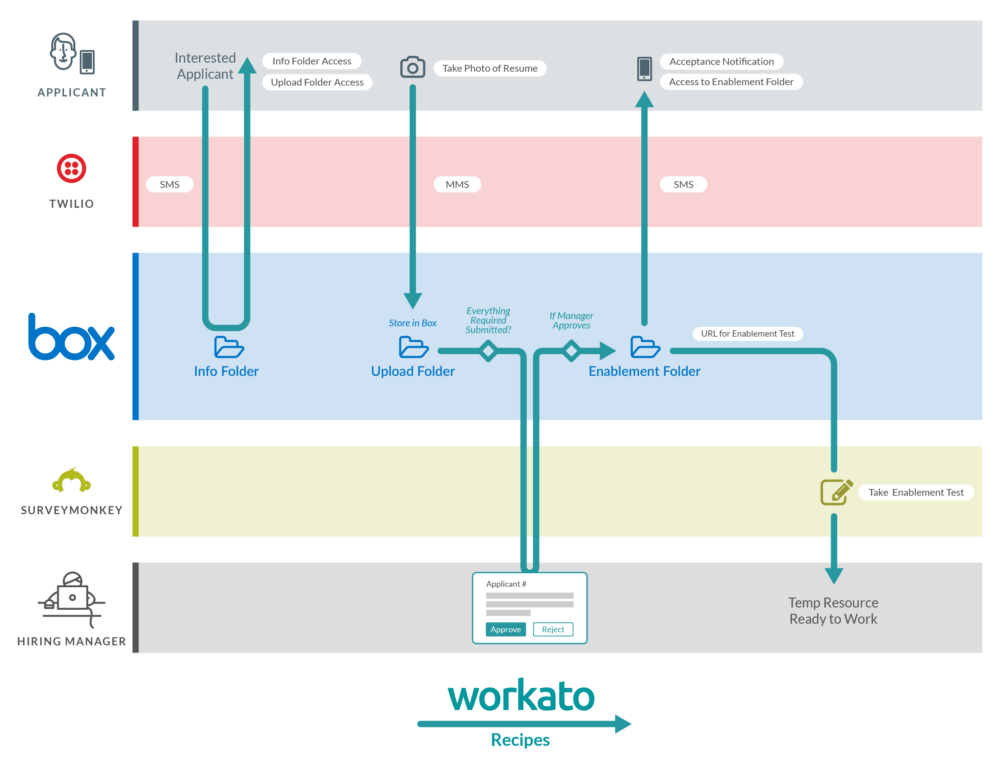HR departments often face increasing pressure to not only attract but also retain highly sought after talent pools. After all, employees form the backbone of a company—and any strong business is only as good as its people. According to Capterra, 75% of hiring managers use either applicant tracking or recruiting software to improve their hiring process. And according to Gartner, cloud-based HR software expenditures are increasing faster than spending on on-premise solutions. In fact, HR cloud solutions will constitute 50% or more of all HR technology spending by the end of this year. But are you getting the full value out of your HR app?
With the rapid development of modern HR solutions, there are lots of useful technologies that can make recruiters more productive. But more apps almost always means more data entry, app-hopping, and information silos.
That’s where recruitment automation comes in. By connecting all of your apps, recruitment automation can help you spend less time on tasks like manual data entry, sending contracts, and writing emails. That’s a plus for any recruiter because it frees you up to focus on what you’re best at: finding the right person for the job.
Workato is an intelligent automation platform (backed by the folks at Workday Ventures, the leading HR app) that allows your business to build workflows across departments and apps. Workato calls these integration workflows recipes, plain English instructions for getting work done between your apps. You’ll see some links to our recipes throughout the piece. Here are five HR recruitment workflows you can implement to jumpstart the first phase of any hiring process and make talent acquisition a less cumbersome experience.
Recruitment Automation: Auto-Gathering HR Documents, Resumes, and Other Applicant Materials
Seamlessly Hiring Temps via Text Message
When it comes to finding the right person among a sea of applicants, time is of the essence. Hiring managers shouldn’t have to focus their time on administrative tasks; instead, they should focus their energy on the actual interview process.
The application process should also be straightforward and hassle-free for candidates. If you’re an interested candidate applying for a new job, wouldn’t it be much easier if you could submit documents right from your smartphone?
Recruitment automation can streamline your #HR workflows and help you spend less time on tasks like manual data entry. Share on XAn efficient application workflow can revolutionize the hiring and screening process, especially when you have a large volume of applicants and need to move quickly. This is often the case when hiring temps, interns, or volunteers. To overcome the roadblocks faced by both HR staff and job candidates, you can create an end-to-end recruitment automation with Box, Twilio, SurveyMonkey, and Workato.
By integrating Twilio and Box, applicants can indicate interest in an open position via SMS. Once they send that text, Workato will create a new Box folder with that candidate’s name and give them access. The applicant can then simply snap a photo of their resume and text it in; Workato will automatically upload the resume photo to the Box folder. Once a new application is submitted, the hiring manager will automatically receive both an SMS notification and an email alert; each notification will also include a link to the Box folder.
To make the candidate selection process even simpler, you can incorporate an approval step into this recruitment automation. Once the hiring manager receives a notification about a new application, they can approve or reject the application right on the Workato platform. If the applicant is a good fit for the job, you can automatically send an acceptance SMS simply by hitting the “accept” button. Successful applicants will then receive links to a Box folder containing employee enablement documents.
This recruitment automation workflow can also be used to automate the process of selecting candidates for additional interviews or screening. The acknowledgment SMS can include a SurveyMonkey link where applicants can complete assessments before being fully approved for work. Once candidates complete the survey, Workato will tabulate the results and send a survey summary to the hiring manager via email.
Related: A guide to automating the resume-screening process
Extracting Data from PDFs and Auto-entering It in Your HR App
Though most recruiting tools require the applicant to fill out tedious web forms, some of the best candidates come in directly via recommendations from current employees or may not be actively looking for a new job and therefore not willing to fill out the long form. Resumes for these candidates are often submitted in PDF form. Because data can be organized in any design the applicant sees fit, it’s very difficult to pull the relevant information from the PDF without manually looking at the resume and entering information into your HR app. This is simply not a sustainable practice.
You can use Workato to ensure everything goes into your HR app painlessly. For example, when a new resume is submitted Workato will send it to Docparser, which will scan the document for relevant information, such as the candidate’s name, contact information, and job experience. Workato will then automatically create a new pre-hire account in Workday or other HR apps like Namely and map that information to the correct fields. Once a candidate’s information exists in Workday, Workato will send a Slack notification to the right HR staff member with all the relevant information the staff member needs to make a decision about the candidate.
From there, right inside of Slack, the staff member can execute an approval workflow and decide whether to move the candidate on to the next round in the hiring process by simply clicking a button. This workflow is enabled by Workato’s bot, Workbot for Slack, which uses a proprietary technology called Verified User Access to securely allow for approval workflows from Slack to other apps like Workday, Namely, Salesforce and more.
Learn more about secure approval workflows from Slack>
Automating the HR Recruitment Follow-Up Process
Automating HR Communications When Using a Non-Traditional HR App like Quick Base
Not every company uses HR-only applications. Your company may have a custom application or use a highly flexible platform like Quick Base. This can make communicating with candidates throughout the recruitment process more manual as there may not be a built-in way to customize and automate communications. Ultimately, you also need to communicate with a high volume of candidates quickly and easily. But sending a large number of personalized emails is a huge drain on your time!
With workflow automation, you can seamlessly send emails to relevant candidate groups based on certain triggers, instead of doing it manually. For example, a national nonprofit with 400 staff, thousands of volunteers and canvassers, and 1.5 million supporters in all 50 states and the District of Columbia uses a custom Quick Base app to store applicant data. The app contains pre-written language for the emails that should be sent to candidates applying for a particular role to let them know next steps or what materials are required. Once a new application is received, Workato can search the Quick Base app for the people who need to receive a particular email; then Workato fires an action to Mandrill to send the right email automatically. This recruitment automation workflow allows HR staff—who would otherwise have spent a lot of time manually organizing candidates and sending out emails—to focus on other more important tasks.
See how this automation works >
Using Slack to Enter Candidate Information Into Your HR App
The first step of the hiring process frequently involves a phone or video interview with a member of the HR team. This conversation is a crucial element of the screening phase before moving on to a more formal in-person interview. After or during this initial call, HR staff often record notes inside an app like Workday or Namely.
Entering information about the candidate from Slack is a useful capability for several reasons:
- If you don’t have a process in place to automatically create a new candidate in your HR app you’ll have to do this manually before the call – sometimes there simply isn’t time when you have back-to-back calls.
- If you do have a process in place, human error and generally being busy may cause notes to be insufficient or forgotten.
Recruitment automation can make it much simpler for HR to record the right information with intelligent prompts inside of Slack. Let’s say you keep your calls scheduled in Google Calendar. Workato’s Workbot for Slack can automatically ping the interviewer via Slack once the call has ended if the candidate does not have a profile in your HR app, and you can automatically create a new profile in Workday or Namely right from Slack. Then Workbot will ask for more information saying: “You just talked to CANDIDATE’S NAME. How did it go?”, “Do you want to move this candidate to the next round of interviews?”. These questions are completely customizable, and once you’ve typed your answers into Slack, Workato will automatically sync them with the candidate’s profile in your HR app.
Automating HR Contract Deployment and Retrieval
Recruitment ends when the contract gets signed and onboarding can begin. You can use automation to seal the deal without any manual work.
You can integrate DocuSign or another e-contract service with your HR app using Workato to automatically send the contract and wait for the contract to come back completed. When a candidates status changes to “hired” in your HR app, Workato will automatically send the correct contract and fill in the candidate’s information. A second Workato automation will monitor DocuSign, waiting for the signed contract to come back. When it does, Workato will automatically place the contract in your HR app on the candidate’s profile and notify you on Slack or via email.
You can create any variation of this recruitment automation that works for your business. The large nonprofit mentioned above uses Workato to integrate DocuSign and QuickBase. When a new hire packet is filled out in DocuSign, Workato grabs information from the contract’s fields and maps it into Quick Base automatically. On the surface, it’s a simple integration, but it brings real value to the HR team by eliminating a lot of manual data entry. It also decreases the likelihood of human error when moving that data around. And because the process moves automatically, it can significantly speed up the onboarding process so new hires can get to work sooner.
Learn more about automating contracts >
Intelligent automation can significantly lighten HR’s workload and make recruitment more efficient. If your HR team uses multiple apps, integrated workflows can streamline complex processes, eliminate the need for manual data entry, minimize errors, and save valuable time. The scenarios in this piece are a great place to start, but each company is unique and has their own way of working; Workato offers over 100,000+ community recipes that you can copy, edit, and reuse to construct your own comprehensive workflows!


